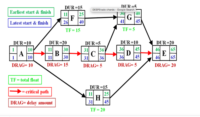We have seen on all our news feeds how inflation is at a 40-year high. It was the early 1980s when the U.S. experienced inflation at the rates we have now, peaking in April 1980 at 14.86%. Did inflation and all the trouble that came with it contribute to the development and wild success of critical path method scheduling software programs in the early 1980s?
I can't say with certainty. I will only state that the value of a tool is evident when a superintendent can use it to complete a 36-month project in only 30 months, or avoid a year's delay, or accelerate completion, at a time when material and labor price escalation can eat up 20% or more of a project budget.
James E. Kelly and Morgan R. Walker developed the CPM algorithm in 1956 to minimize downtime while renovating a process plant. Later, the algorithm was used to accelerate the U.S. space program and moon landing project (the USSR had a head start with Sputnik). While CPM's progress from 1956 to the early 1980s was slowed by the need to run the program on massive, costly and difficult-to-operate mainframe computers, the newfangled “untethered” personal computer made it possible to provide CPM scheduling directly to the construction superintendent and the rest of the project team.
 |
| Plotnick |
The team demanded and the marketplace of software developers provided the product. Both Primavera P3 and Welcom Open Plan were launched in 1983 to assist users in speeding their projects to timely or earliest possible completion.
The value of planning and scheduling declined with the taming of inflation in the 1980s. But other megatrends were reshaping business in the U.S.
Partly the result of inflation and other economic pressure, university and college business schools as early as the 1950s and 1960s had started to upgrade their curriculum to offer new post-graduate masters of business administration programs. As the graduates rose to lead major companies and positions in government, the engineer as king—a feeling of cultural respect triggered by WWII and the industrial expansion that followed—was supplanted by the MBA as emperor.
And the courses these MBAs studied focused on scheduling designed to achieve best productivity and utilization of resources rather than earliest completion.
Another megatrend, partly the result of management of, by and for MBAs, was consolidation. Synergies across vast conglomerates of only loosely related entities were sought. Once again, the emphasis shifted away from earliest completion of any one project to the allocation of resources and combined economic impact of the enterprise. The software developers of the 1990s and beyond have focused more upon the dictates of the C-Suite MBAs rather than those of project-oriented engineers.
This resurgence of inflation after 40 years may presage a renewed interest in critical path method schedule analysis. And so, after a two-year hiatus caused by the pandemic, the Construction CPM Conference will again host our 2023 meeting of planning and scheduling professionals at Disney World in Orlando, January 16-19. We hope to see you there. For more information, visit http://constructioncpm.com





Post a comment to this article
Report Abusive Comment